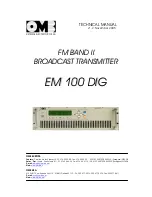
FM Transmitter
Sistemas Electrónicos S.A EM 100 DIG
Technical Manual - v1.2 - November 2005
3
GENERAL SAFETY RECOMMENDATIONS
When connecting the equipment to the Mains power, please follow these important
recommendations:
This product is intended to operate from a power source that will not apply more than 10% of
the voltage specified on the rear panel between the supply conductors or between either supply
conductor and ground. A protective-ground connection by means of the grounding conductor
in the power cord is essential for a safe operation.
This equipment is also grounded through the grounding conductor of the power cord. To avoid
electrical shock, plug the power cord into a properly wired socket before connecting to the
product input or output terminals.
Upon loss of the protective-ground connection, all accessible conductive parts (including parts
that may appear to be insulated) can render an electric shock.
Equipment must be connected
to station's ground system before any attempt to connect it to Mains electrical supply.
To avoid fire hazard, use only fuses of the type, voltage rating, and current rating specified in
this manual. For fuse replacement, always refer to User’s Manual.
To avoid explosion, do not operate this equipment in an explosive atmosphere.
To avoid personal injury, do not remove the product covers or panels. Do not operate the
product without the covers and panels properly installed.
GOOD PRACTICES
During the maintenance of the equipment covered in this Manual, please keep in mind the
following standard good practices:
When connecting any instrument (wattmeter, spectrum analyzer, etc.) to a high frequency output,
use the appropriate attenuator or dummy load to protect the final amplifiers and the instrument
input.
When inserting or removing printed circuit boards (PCBs), cable connectors, or fuses, always turn off
power from the affected part of the equipment. After power is removed, allow sufficient time for the
capacitors to bleed down before reinserting PCBs.
Always use discharge stick
when available.
When troubleshooting, remember that FETs and other metal-oxide-semiconductor (MOS) devices
may appear defective because of leakage between traces or component leads on the printed
circuit board. Clean the printed circuit board and recheck the MOS device before assuming it is
defective.
When replacing MOS devices, follow standard practices to avoid damage caused by static
charges and soldering.
When removing components from PCBs (particularly ICs), use care to avoid damaging PCB traces.






















